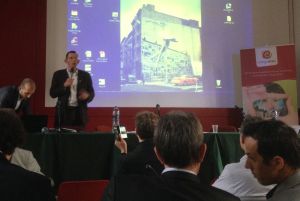Archive for “Originally posted on Transition Network” category
Showing results 61 - 65 of 383 for the category: Originally posted on Transition Network.
9 Dec 2015
Continuing our exploration of the Transition Story project, we asked different National Hubs for their reflections on the blog that opened our theme on the Transition Story. Today Silvana Bañados of the Transition Chile Hub shares her thoughts:
“During our first Chile National Hub meeting, different answers were generated referring to the question Rob set out, that the presentation of the Transition Movement – based on the threats of climate change and financial recession derived from Peak Oil – were negative and reactive. Through a Think and Listen session + round of reflections within a group of 25 representatives of local initiatives, the following key ideas were generated:
- It is important to recognize, give space to the challenges our civilization are facing. That is, we must recognize and know deeply our current reality. The key is not to remain immobilized by it
- This impact of facing reality, although hard or painful, it is necessary to leave the comfort zone
- However, this should be just the beginning. It is necessary to generate the motivation with a positive attitude. All actions must be performed from this stance
- It is an invitation to be fine, either individually or in a community. To flow from the fear to a loving empowerment
- Emphasize the role of good relationships among people
- Experience technological and social solutions to challenges such as climate change and Peak Oi in order to validate empirically the usefulness of these solutions
- It is recognized that there are many more challenges such as inequality, violence, loss of biodiversity, etc., in addition to Peak Oil and Climate Change
- Key for the next version of Transition to remember the roots of the Transition Movement in Permaculture and it´s based in design science as a discipline and profession. For us in Chile the Transition Movement came as just a rewording of the permaculture concepts and its design principles and tools to make them more available and easy to understand for the mainstream. But it seems that at an international level this has been forgotten and not clearly recognized and valued by the movement. It is relevant at this stage to manifest and honor these roots as a basis for the future vision of the transition movement and the planning of coherent next steps
Texto: Marco Ossandón
Read more»
8 Dec 2015
I don’t remember a winter as mild as the one the UK is currently experiencing. Today was only the second frost of the year and it’s the 9th of December. That comes, of course, in the context of what climatologists argue looks 97% likely to be the hottest year on record. My father passed away a couple of years ago, and when my sister and I were clearing out his house, we found lots of photos that he took (he was a keen photographer) when he lived in London in the 1960s. One set of rather beautiful photos capture an event which feels unimaginable today, the Great Freeze of 1963, when the River Thames froze. The photos are taken from the Hampton Court Road.
January 1963 was the coldest January since 1814, the last time the Thames had frozen. I share them today for several reasons, firstly because they are very beautiful photos, published here for the first time. Secondly in memory of my dear dad. Thirdly because the offer an insight into a very different climate, one we have left behind. And lastly because, as someone who has come off his bike several times on patches of black ice, I’m intrigued as to why anyone would think it a good idea to cycle on a frozen river?


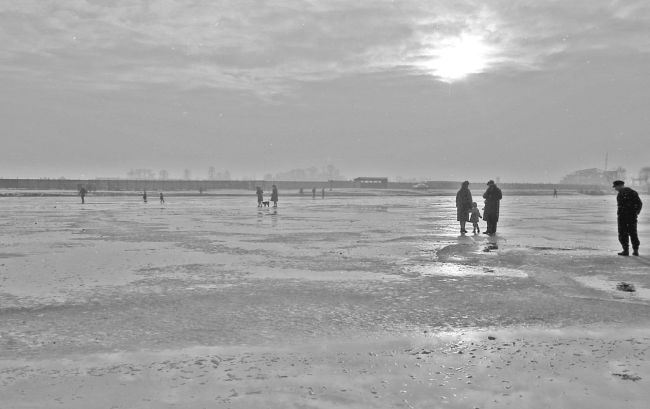

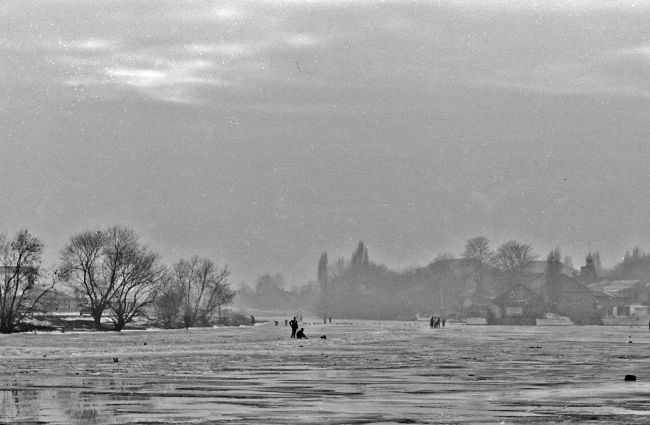
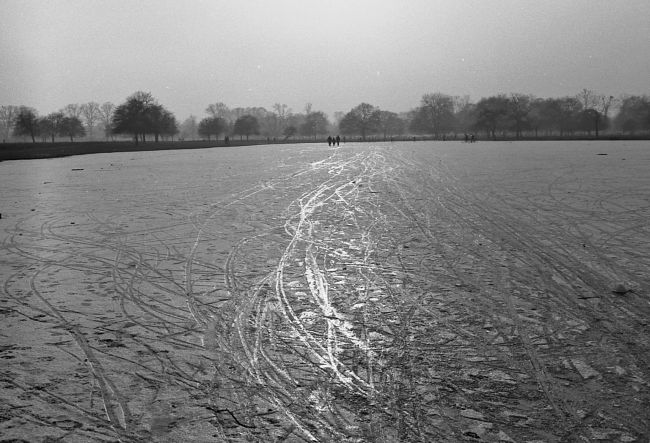

Read more»
7 Dec 2015
The Solutions COP21 event at Grand Palais that I had visited the previous day was, thanks to its paucity of actual solutions, potentially liable to being sued under the French version of the Trades Descriptions Act. Anyone wandering its halls would have been hard put to find much that actually built resilient local economies, social justice, a more equal society, and one capable of living within anything approaching limits. Thank goodness then for the Alternatiba Village of Alternatives, taking place in Montreuil, a suburb of Paris.
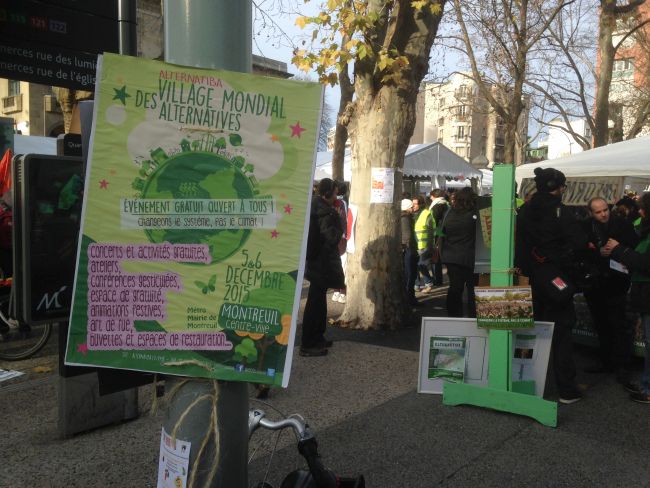
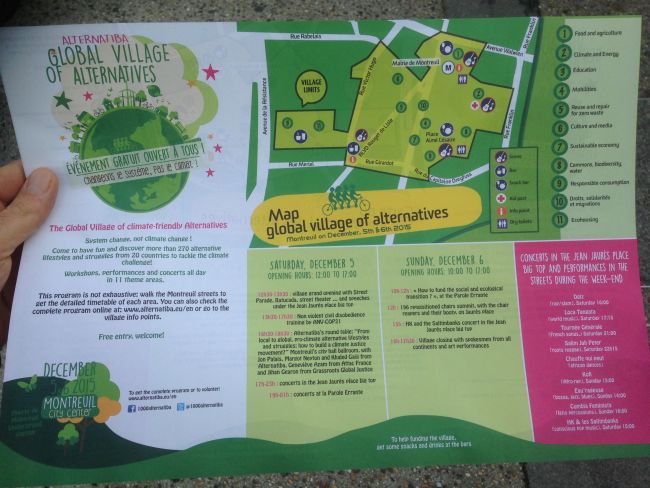
Alternatiba has been an amazing initiative in the run up to COP21, with activists cycling across Europe, working with communities to set up solutions and to inspire them with the possibilities of COP21. Many Transition groups have got involved too. The Village of Alternatives was sufficiently far out of the city centre to have escaped the horrendous over-policing happening elsewhere. It created a vital space for those involved in the creation and promotion of actual solutions to celebrate, to meet and to breathe after the oppressive feeling of the first week. Here’s a video taste of what it was like to wander around there, with the Transition stall at the end…
Set out over a large area, the Village featured stalls, music, food, talks and workshops. It was laid out into a number of distinct areas: food and farming, climate and energy, education, transport, making/repairing/zero waste, culture and media, sustainable economy/meaningful work/responsible finance, commons/biodiversity/water, responsible consumption, human right/solidarity and migrations, habitat and a food market.
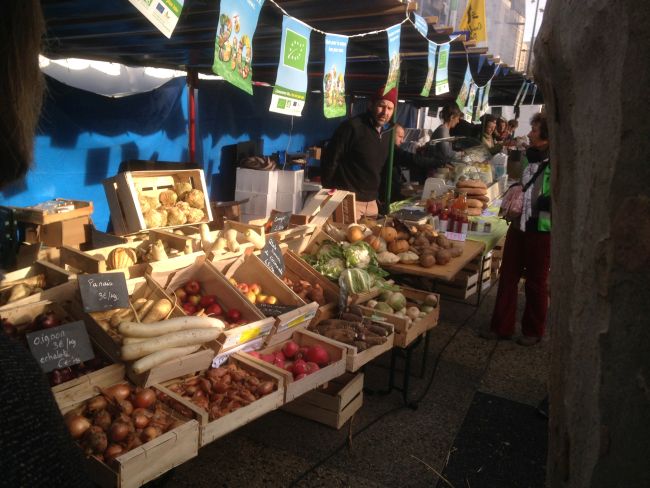
Those running stalls were asked to also run workshops, debates, everything possible to give the Village a sense of being a place of learning, action and sharing. Unlike the Grand Palais, the Village featured tried-and-tested stuff, responses that value and respect soil, community, biodiversity and culture. Solutions that are about returning power to the 99% rather than the 1%. Unlike Grand Palais, where the only conversations encouraged were those with trained salespeople and corporate representatives, where anything other than that, one felt, carried the risk of being literally carried out of the building by undercover police officers, the Village buzzed with the sound of laughter, conversation and the sharing of ideas.
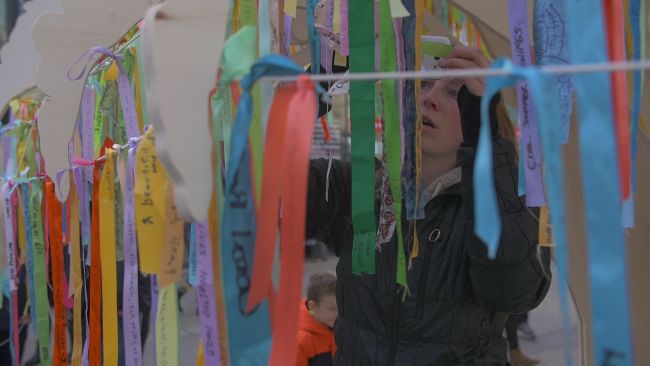
Transition was represented with a stall showcasing some of the 120 Transition groups from across France. I spent some time walking around, dropped into the permaculture and Incredible Edible stalls, admired the food and beer on sale, and admired the number of polar bears walking around. Anyone who tells you the polar bears are unable to adapt to climate change really has no idea what they are talking about. Some of them have moved to Paris and taken up work as street entertainers:

…and some have even found employment as on-stage dangers!

Their powers of adaptation have clearly been underestimated…
Although we only got to spend a couple of hours at the Alternatiba village, it was much needed, in spite of the cold! Spaces where civil society can come together to share ideas and inspiration are vital, and due to the Special Measures imposed in France, have been in short supply this week.
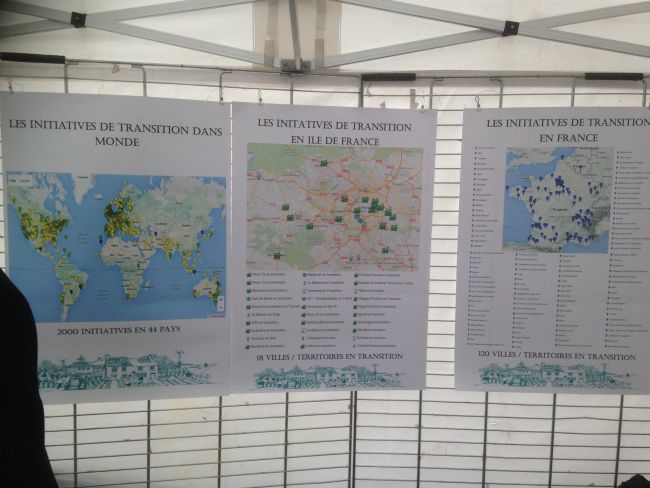
We then went to La Villette, a great place which is the redevelopment of an old abattoir, now a venue for music and arts events and also featuring one of the best urban food gardens in France. The first event there was the launch of Terra Viva: A People’s Pact to Protect the Planet and Each Other, created by a coalition of groups, and presented by Dr Vandana Shiva. You can read the Pact here.
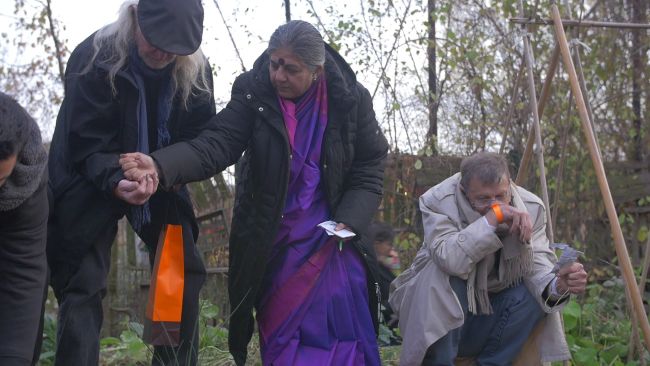
It was launched with the symbolic planting of a ‘Garden of Hope’, with a group of farmers planting seeds. After this, the Pact was read out by 10 different people representing different movements. I read one of them.
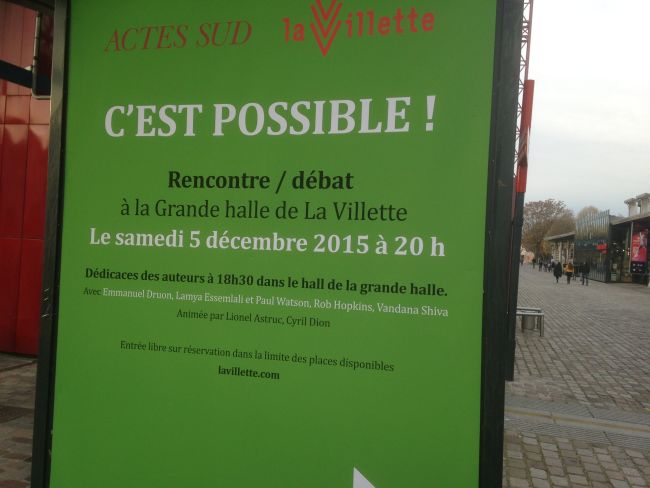
The evening event was called ‘C’est Possible’ (“It is possible”), co-presented by La Villette and Actes Sud, publisher of books by, or about all of the evening’s speakers: Emmanuel Druon, Lamya Essemlali and Paul Watson of the Sea Shepherd Conservation Society, Vandana Shiva and me. The evening featured a short film about each of us and a five minute reflection each on the theme of “what makes you think that change is possible?” It then was built around questions from the audience and reflections from each of us on the panel. It was actually really good fun, and some great discussions were had. It was filmed, and if it gets posted online anywhere, I will let you know.
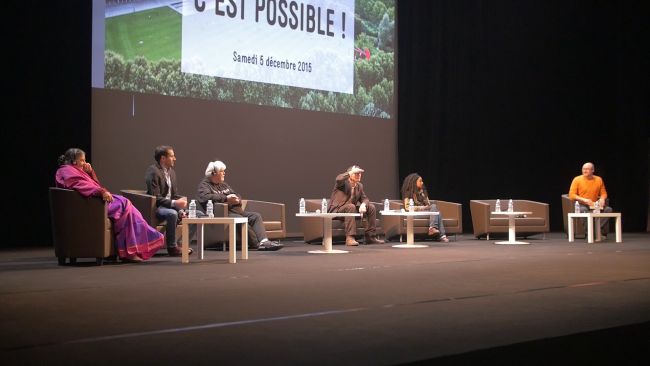

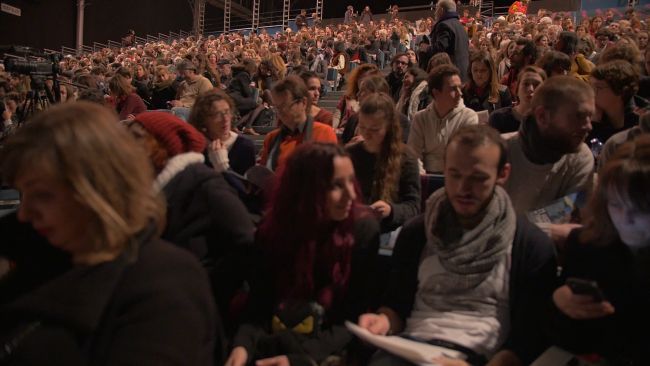
Afterwards, we each did a book signing, and the Transition team also sold out of all the copies of ’21 Stories of Transition’ that they had brought along. What was wonderful, as with the previous night’s event, and indeed most of the events during the week, was how many young people there were there, and how moved and inspired they were by it. It is hugely touching to see that, and just how many came up to say “thank you”. Eventually it got late, and all the books were sold, and the evening wound down with pizza and a beer. Very enjoyable.

The next morning required waking up again after just under 4 hours’ sleep before heading for home on the Eurostar, but that’s another day and another story. It will take a few days for the dust to settle in my brain and I will write some kind of a reflections piece. But right now I will be taking a couple of days to rest and refresh. Thanks for reading all these, I hope you have found them illuminating and useful.
Read more»
5 Dec 2015
Today was the most thought-provoking day, at times viscerally so. The logo for COP21 says ‘Tous ensemble pour le climat’, or “all together for the climate” (see right). Yet today was a day when the battle lines felt clearly drawn, or rather the two extremes on display here came into stark, and alarming contrast. Out at Le Bourget, the negotations continue. Big disputes are opening up around whether the final agreement should be focused on limiting warming to 1.5 degrees, the only realistic solution as argued by the science, or 2 degrees, a pretty random figure that is politically expedient rather than actually useful, and which for some nations is already felt to be a huge stretch. The small island states, those with the most to lose, are arguing for 1.5. As the Guardian reports, ” Saudi Arabia and India [are] flatly refusing attempts to even “reference” a UN study saying a 1.5 degree target was safer than 2 degrees”. “Shame on them”, is the only human response.
For me, I had been invited to speak at Solutions COP21 at the Grand Palais, a huge venue built for the World Fair at the turn of the twentieth century, a vast building with a greenhouse roof. The decision to speak at the event was one that provoked a lot of conversation and discussion in the Transition Network team, given that for many, the event was the great showcase of corporate greenwash at COP21.
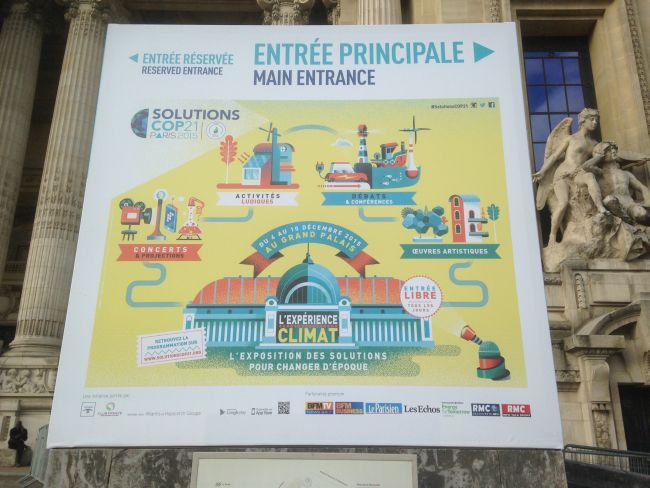
My sense with such things is that there one can often find reasons not to speak in places, but if I am invited, I usually go, seeing my role as being to speak to people, and to tell it how I see it, not what I in any sense feel I ‘ought’ to say. You never know in such settings who you might touch and how it might affect peoples’ lives. And so off to Grand Palais we went. Just inside the door of the Palais was a large display explaining what the event was about. Here’s what it said:
We hear a lot of talk about climate, and about COP21, but what do we know exactly? How will climate change affect our daily lives?
In the mythical venue that was host to several world fairs, you can discover the solutions that are contributing to the fight against climate change. It’s not just about adopting a responsible approach, but will also and above all an opportunity to improve our daily lives. With new usages, new inventions, new professions, and practical existing solutions to take us to a post-carbon society.
For 7 days, more than 500 organisations, including 200 partners and associate partners – associations, scientists, academics, institutions, SMEs/SMIs, large corporations and regional collectives – will present their climate solutions and offer us a new vision and a unique experience.
Solutions COP21 is here to prove to both young and old that the commitment will be beneficial to each and every one of us.
Outside was a demonstration called ‘False Solutions’, drawing attention to the greenwashing going on inside, a demonstration which, it appeared to me, just wanted to hang up its banner with “No peace with climate justice” written on it. The police present was huge, Robocop police with shields and batons and riot vans as far as the eye could see.
The first thing I did once we had got through the huge queues to get in, was to be part of a televised panel discussion/debate thing with Brice Lalonde, Philippe Madec (architect), Jean-François Caron (The Mayor of Loos-en-Gohelle). It was all very swish, high production values, but one of those things where the host is so keen to ask the next question that as soon as you start answering yours, you get the feeling he wants you to finish again. I think the video will be posted soon, but for now, here are some photos.


After that, Corinne of Transition Paris and I went for a walk around the exhibition to enjoy and experience the “new vision and a unique experience”. While the former is debateable, it certainly delivered on the latter. It was a vision of the future that would have you believe that the only contribution to a “post-carbon future” that communities and actual people could make is wobbly furniture made from old palettes, flowers made from recycled stuff and sticking things onto masks as an arts project. Everything else needs big companies.
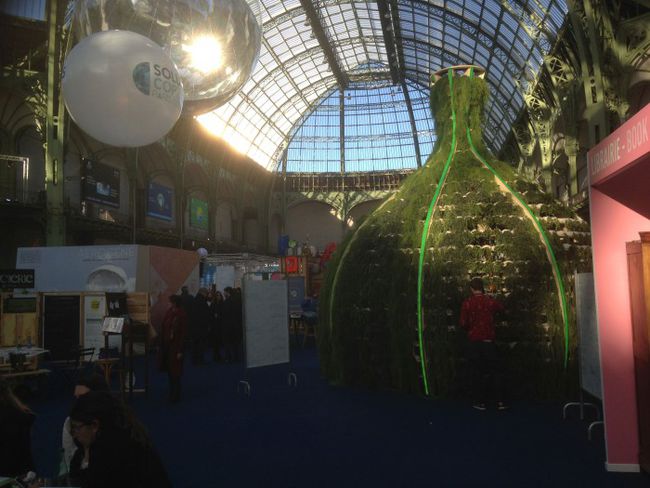
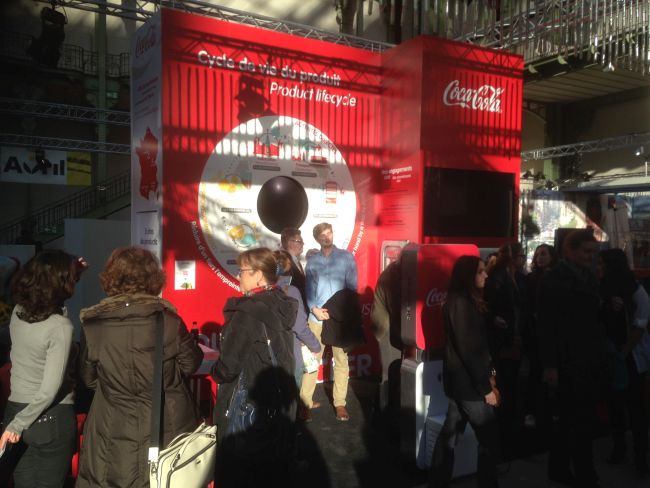
The experience included Renault Nissan presenting their electric cars, L’Oreal presenting themselves as ‘green’ due to being “committed to a sustainable sourcing of renewable raw materials”, Coca Cola presenting themselves as being part of the solution due to the fact that 90% of Coca Cola is made in France. There were ‘sustainable’ electric Formula One racing cars, all manner of dubious companies bigging up their green activities, such as energy companies, with no mention of the word “fracking”, for example, appearing anywhere.

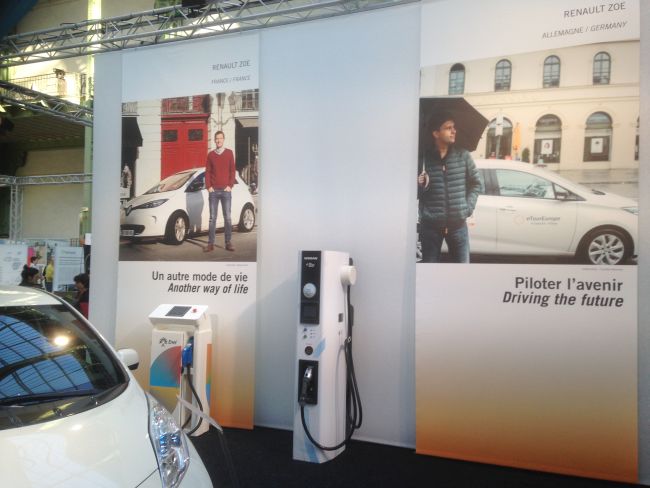
A hadnful demonstrators managed to get inside the building, and were quickly led out by groups of police. It was quite something to see, the first time I have seen police snatch squads in operation. A large group of plain clothes police, some marked as police but most not, would just pounce on someone and carry (literally) them out at great speed.
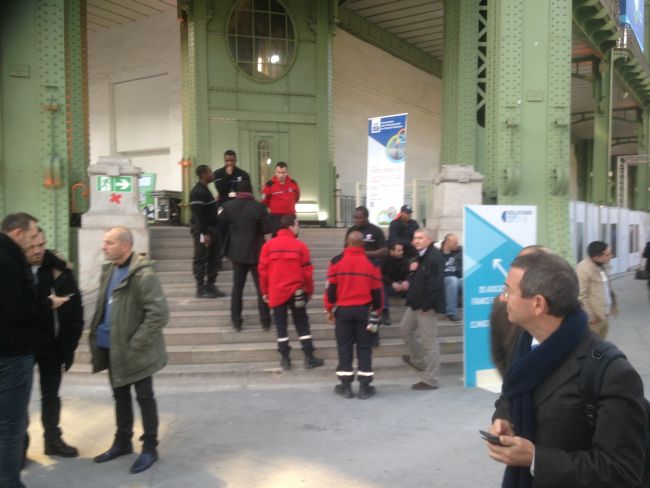
One moment you’d be standing talking to someone, and the next someone just near you would be lifted up and sped from the building. Here’s my film to give you a taste of what it was like in there, which includes the moment two journalists were snatched and taken out, with the woman shouting “we have a press pass!”. It was deeply unpleasant. Alternatively perhaps, the French police were modelling a new form of post carbon transport? Or perhaps not..
Outside, as we left, the police were removing one demonstrator who had climbed into a lamppost, and then it was clear that they were preparing to wade into the demonstrators. One officer, with a tannoy, said “you must disperse, this is an illegal demonstration”, and the riot shields and batons began to twitch, at which point we took our leave. All deeply unpleasant, given that so far as I could see all the demonstrators wanted to do was to show their banner and blow a few whistles. Yet the police operation was huge, with hundreds of riot vans and massive numbers of police. The intolerance of dissent and the rush to over-the-top aggressive policing was deeply troubling.

That evening we went to the Universite de la Terre near the Eiffel Tower for an event which included a section linked to the film Demain about which I waxed so lyrical the other day. It was an odd event, which felt like three entirely unrelated things stapled together. First there was a musical performance which mixed music by Handel and others with photos of the Calais refugee camp and some prose that told the Christmas story, ending with a choir singing “Hallelujah” from the balcony.

In the central part, Mélanie Laurent and Cyril Dion from Demain took the stage, and spoke about the film and took questions from the audience. I was invited up and talked a bit. At one point Cyril reflected powerfully on the recent terrorist events and spoke about how, for him, the stories in Demain, and their focus on reducing oil consumption, are one of the key ways of reducing conflict in the world.

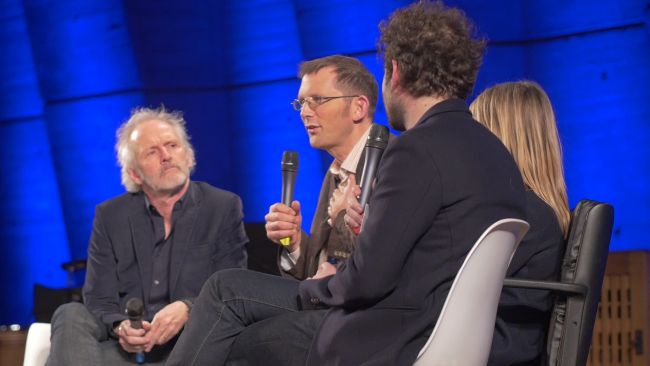
The last part of the evening was the ‘Farm for a Future’ awards, where 15 sustainable farmers talked about their work and awards were given out. After that, we sold books for a while and met lots of people, and very enjoyable it was.
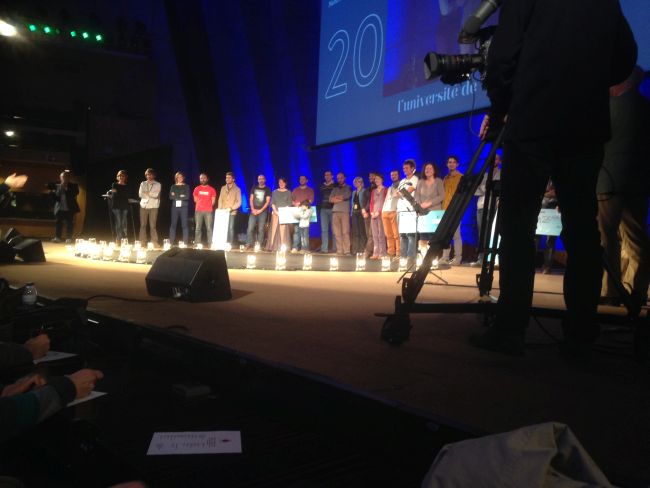
What was most fascinating about an event called ‘Solutions COP21’ was the poverty of solutions to be found under the vast ceiling of the Grand Palais. For all the promise that we were about to “discover the solutions that are contributing to the fight against climate change”, there was actually virtually nothing that would do that. Corinne, my host, and I, got into conversation with a woman on a stall for a company who are building a huge tunnel under the Alps for trains. “But isn’t there one already?”, we asked. “Well yes there is”, she replied, “but this one would be bigger”. “But why does the tunnel need to be bigger?” we asked. “The journey will be an hour shorter”, she said, adding “and it could carry more freight, so it’ll save carbon. We didn’t get into talking about the embodied energy of digging such a tunnel. Or that actually taking a train through the Alps is something that most people don’t mind taking an hour longer as it is so gorgeous. Or why does everything need to always be getting bigger and faster? The idea that our “post-carbon future” will be one of more, of growth, of corporations allowed to function as they please, was the overwhelming worldview on display at Solutions COP21.

And yet the arguments challenging this, the growing number of voices questioning growth all around the world, as Demain does so powerfully, are growing steadily. And as they grow, the backlashes against them grow more vociferous and more absurd. There’s Leigh Phillips’ execrable book ‘Austerity Ecology’ which we reviewed recently, and a couple of days ago in the New York Times, Eduardo Porter wrote:
“Zero growth gave us Gengis Khan and the Middle Ages, conquest and subjugation. It fostered an order in which the only mechanism to get ahead was to plunder one’s neighbour. Economic growth opened up a much better alternative: trade”.
Of course “plundering one’s neighbour isn’t something we do anymore, right? And “trade” and “plundering one’s neighbour” are entirely separate things, right? Much of Solutions COP21 was rooted in “conquest and subjugation”, as, sadly, was the event’s policing. As I said, a thought-provoking day.
Read more»
4 Dec 2015
I spent the morning at Place to B doing interviews, one for National Geographic France, and the other with an online magazine who wanted to know what my ideal house would be like in 2050. Enjoyed that. Given that I would be 82 by then, it was a rather fetching strawbale home with clay plasters, part of a collection of houses with, no doubt, a rather fetching rocking chair and some splendid slippers. And ideally with trees growing on the roof. The idea was that they would then get an artist to draw a picture of your future house, so I look forward to seeing that. Simultaneously, Albert Bates of Global Ecovillage Network and other things, gave a talk organised by Transition Paris in a bar round the corner which sounded great.

In the afternoon several of us travelled across the city to Paris Maison de l’Europe, a rather fine venue for a meeting organised by Energy Cities, and hosted by the City of Paris. It was called COPowering change: the role of local governance in delivering the energy transition, and the audience brought together Mayors and local government from around the world.


I talked about the places where Transition overlaps with local government, and what that ‘edge’ looks like. You can download my slides at the bottom of this post, and here is the audio of my talk. Feel free to download both and to almost create a substandard version of me giving a presentation in your very own living room. Cut out a picture of my face and stick it on the cat, be almost like I’m actually there. Never let it be said that we don’t spoil you rotten here at Transition Culture.

After the talk there were presentations from Mayors from different places, including Daniella Radice, deputy Mayor of Bristol, who, rather charmingly, traced many of the climate change activities happening in Bristol to hearing me speak in Bristol in 2007! So any time you think that talks you give aren’t having an impact, think again. You never know who might be there, and how it might touch them.

When the session as a whole came to a close there was drinks and nibbles (unless, like me, you’re vegetarian, a demographic which Paris, in spite of its many other charms, neglects somewhat) and meeting lots of interesting folks. We also sold some of our ’21 Stories of Transition’ books, thanks to our wonderful salesman, the lovely Henry.
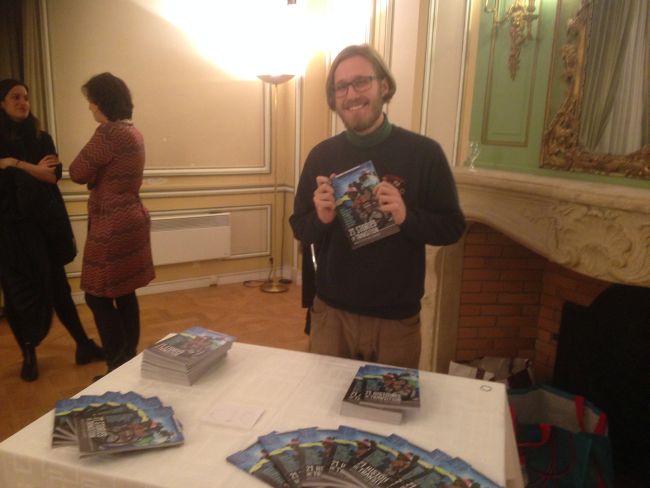
And that was kind of it really. A few of us went out for pizza, and on the Metro on the way home, I took this photo of really quite the most appalling Christmas jumper I’ve seen since about 1978. This jumper is advertised all across Paris. I really can’t imagine even one person buying this, never mind enough people to warrant to cost of advertising it. Buy hey, I’m most likely completely wrong on that…
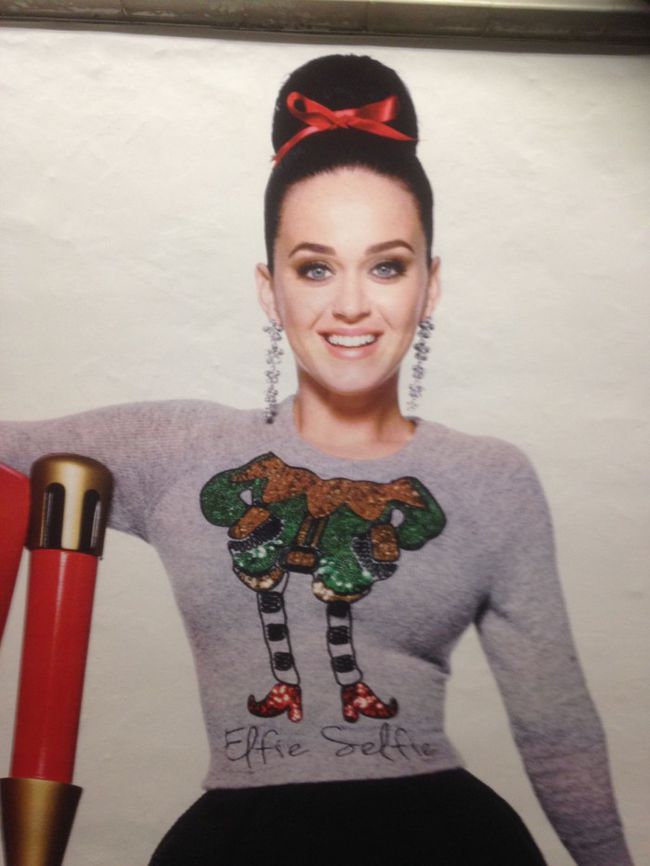
Read more»






































